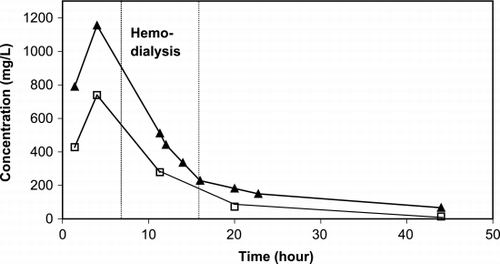To the Editor:
Acute valproic acid intoxication may cause severe complications. Hepatoxicity, respiratory failure, hyperammonemia, central nervous system toxicity varying from drowsiness to coma and even death have been reported Citation1Citation2. Recommendations for treatment have included symptomatic care, gastric lavage and subsequent multiple dosing of activated charcoal Citation1Citation2. The additional benefits of extracorporeal interventions including hemofiltration, hemoperfusion alone or in combination with serial hemodialysis have been reported recently Citation2Citation3Citation4. However, there is limited experience with the effectiveness of hemodialysis alone in acute valproic acid overdose Citation5Citation6. We report a case with severe valproic acid overdose in which hemodialysis was used successfully.
A 41‐year‐old, 70‐kg, white man was admitted to the emergency department of our hospital after self‐reported ingestion of about 50,000 mg valproic acid as extended‐release 500 mg tablets 2 h before. He was known to suffer from epilepsy and was not on any other medications. The man was found conscious at home, but he rapidly became lethargic at admission. He was haemodynamically stable with blood pressure 129/101 mmHg, heart rate 90 beats per minute, and respiratory rate 15 breaths per minute. Liver function tests were normal. Supportive therapy was started after performing gastric lavage and administering activated charcoal and the laxative sodium sulfate.
Valproic acid levels were measured using a fluorescent polarization immunoassay (Roche Diagnostics GmbH, Mannheim, Germany). The assay range was 0–150 mg/l. Free valproic acid concentrations were measured after ultrafiltration of the plasma sample.
Total plasma valproic acid concentration was 789 mg/L (therapeutic range 50–100 mg/L) at admission and increased to 1150 mg/L after 2 h of hospitalization. Fatalities have been described at this concentration Citation7 so hemodialysis was initiated approximately 6 h after his arrival and was performed over an 8 h period. A high‐flux polysulfone membrane (Polyflux 14S, Gambro, Hechingen, Germany) was used, dialysate flow rate was 500 mL/min, and mean blood flow rate was 200 mL/min. Also, a single bolus of l‐carnitine (20 mg/kg) was administered intravenously postdialysis as prophylaxis against liver dysfunction and hyperammonemia Citation2. The patient recovered fully and was discharged 48 h after admission.
Both total plasma valproic acid concentration and its free concentration vs. time are depicted in . The calculated plasma half‐life time was about 4 h during hemodialysis (derived from t = 11.3 h and t = 16 h) and 15.8 h postdialysis (derived from t = 16 h and t = 44 h). Concentration of unbound valproic acid prior to hemodialysis increased dramatically from 400 mg/L to 781 mg/L, resulting in a protein binding of nearly 35% (normally > 80%). The protein binding gradually normalized after treatment, ranging from 40% to 80% at 4 h and 28 h postdialysis, respectively. No redistribution effect could be seen after cessation of hemodialysis.
The increase of the unbound valproic acid concentration in acute intoxication may be explained by saturation of plasma proteins. This phenomenon, the relatively small distribution volume (0.1–0.5 L/kg), and its low molecular weight (144.2 Dalton), suggest that hemodialysis would be an effective procedure in severe acute valproic acid overdose. The plasma half‐life during hemodialysis ranged from 1.7h to 7.3h, similar to case reports describing hemofiltration, hemoperfusion, or hemodialysis Citation2Citation3Citation4Citation5Citation6.
From this case report, we conclude that hemodialysis might be an effective option in the treatment of severe acute valproic acid intoxication.
C. P. E. Guillaume
L. Stolk
Department of Clinical Pharmacy and Toxicology,
University Hospital Maastricht,
Postbus 5800, Maastricht 6202 AZ, The Netherlands
Fax: (+ 31) 43‐3874731
E‐mail: [email protected]
T. F. Dejagere
J. P. Kooman
Department of Internal Medicine and Nephrology,
University Hospital Maastricht,
The Netherlands
References
- Ellenhorn's Medical Toxicology. Diagnosis and Treatment of Human Poisoning2nd Ed., M J Ellenhorn. Williams & Wilkins, Baltimore 1997; 609–610
- Leikin J B, Paloucek F P. Poisoning & Toxicology Handbook3rd Ed. Lexi‐Comp Inc., Hudson 2002; 554–555
- Franssen E JF, van Essen G G, Portman A T, de Jong J, Go G, Stegeman C A, Uges D RA. Valproic acid toxicokinetics: serial hemodialysis and hemoperfusion. Ther Drug Monit 1999; 21: 289–292, [PUBMED], [INFOTRIEVE], [CSA]
- van Keulen J G, van Wijk J AE, Touw D J, van der Deure J, Markhorst D G, Gemke R JBJ. Effectiveness of haemofiltration in valproic acid intoxication. Acta Pædiatr 2001; 90: 958–959, [CSA]
- Kane S L, Constatiner M, Staubus A E, Meinecke C D, Sedor J R. High‐flux hemodialysis without hemoperfusion is effective in acute valproic acid overdose. Ann Pharmacother 2000; 34: 1146–1151, [PUBMED], [INFOTRIEVE], [CROSSREF], [CSA]
- Hicks L K, McFarlane P A. Valproic acid overdose and haemodialysis. Nephrol Dial Transplant 2001; 16: 1483–1486, [PUBMED], [INFOTRIEVE], [CROSSREF], [CSA]
- Poklis A, Poklis J L, Trautman D, Treece C, Backer R, Harvey C M. Disposition of valproic acid in a case of fatal intoxication. J Anal Toxicol 1998; 22: 537–540, [PUBMED], [INFOTRIEVE], [CSA]

